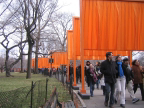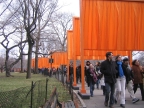What is installation art?
“This is different.”
“I am not familiar with installation art.”
“How is this art?”
These are some questions that are being asked about our current exhibit, The Waiting Room: Lost & Found. It is not an exhibit of traditional paintings, drawings or sculpture. However, this exhibit incorporates aspects of these types of art such as the sculptural chairs or digital imagery. Installation art is a contemporary discipline that is different from a traditional art in many visual ways as well as conceptual.
“Installation art sits right on that curious border between architecture, art and interior design—part physical experiment, part personal expression and part designed space.” Through an artist’s vision, the gallery is reconfigured, transformed into another place. The viewer feels that the familiar space is now something else entirely—a waiting room at the doctor’s office, the psychiatrist’s office, or the dementia patient’s private living quarters. We inhabit this world and are now participants of this experience with the sights and sounds encouraging us to understand what each of these afflictions might be like.
In the late 1960s, artists began to look for new methods of expression beyond painting. They wanted to talk about social or historical concerns and did not want to be tied to making objects for the buyer’s market. One inspiration for experimental artists was Kurt Schwitters who altered interior spaces including his home, Merzbau, in 1920s. These site-specific artworks were interior and architectural, transforming the surfaces of a room with angles and columns painted white. Installation art, as it began to be called in the 1970s, soon became a popular art form constructed inside or out (in the environment).
Installations are most frequently temporary which means that the photographic record is all the remains. How then does the artist support this type of large-scale work? Usually, installations are funded through grants or private foundations. Jeanne Claude and Christo who created The Gates in New York City raise their own funds to create their environmental installations.
Asking the viewer to go beyond just observation of the artwork and inviting interaction is more challenging. As the viewer moves around the installation—in and out of each Waiting Room scene or tableau, listening to stories of real people and visually encountering artistic representations of each condition, she/he is immersed in the problems associated with each. As a social commentary, this installation attempts to heighten our awareness of contemporary women’s health issues and concerns.
http://dornob.com/design/more/installation-art/Find out more about this interesting art form at your Library:












